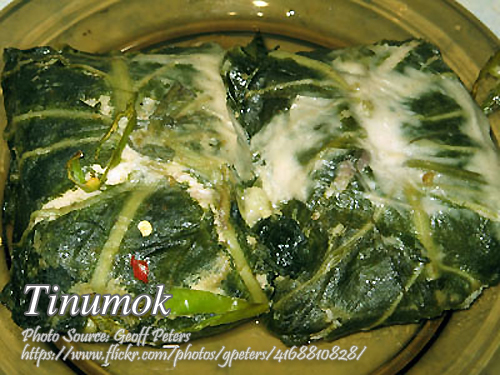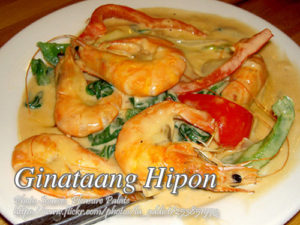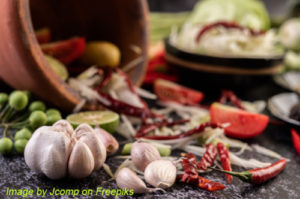Tinumok is gabi or taro root leaves filled with mixture of shrimps, flakes fish, buko meat, onion, shrimp paste and boiled in coconut milk. This recipe is very similar to ginataang laing which gabi leaves cooked in coconut milk with pork or fish but the only difference is this recipe use whole gabi leaves then filled with the ingredients mentioned above.
A Delicious Blend of Shrimp, Fish, and Taro Leaves in Coconut Milk
Also known as “ginataang laing sa dahon ng gabi,” is a delightful Filipino dish that features a unique combination of flavors and textures. It is made by wrapping a mixture of shrimps, flaked fish, buko meat, onion, and shrimp paste in taro leaves, then boiling them in coconut milk. This dish is a variation of the more common ginataang laing, which uses gabi leaves cooked in coconut milk with pork or fish.However, it uses whole gabi leaves filled with a savory mixture, giving it a distinct taste and presentation. Here’s how you can make this delectable dish at home.
Preparing the Filling
Start by preparing the filling for your tinumok. Peel the shrimps and chop them into small pieces. Flake the fish and set it aside. Finely chop an onion and mince some ginger. Lastly, prepare the buko meat by grating it or cutting it into small pieces.
Preparing the Taro Leaves
Before wrapping the filling, it’s essential to prepare the taro leaves properly. Wash the leaves thoroughly and wipe them to remove any excess water. This step ensures that the leaves are clean and ready to use.
Wrapping the Filling
Take a gabi leaf and place about 30 grams of the filling mixture in the center. Fold both ends of the leaf over the filling and secure them with a thread. This step ensures that the filling stays inside the leaf during cooking.
Cooking the Tinumok
In a pan, arrange the wrapped gabi leaves. Add bagoong alamang on top of the leaves, and then pour 2 cups of coconut milk (gata) over them. Bring the pan to a boil over low heat and let it simmer until the gabi leaves are tender and the filling is cooked through. Season with salt and pepper to taste.
Serving the Tinumok
Once the dish is cooked, remove the thread from the leaves and discard them. To serve, place the wrapped gabi leaves on a plate and drizzle with 2 tablespoons of thick coconut cream. This adds an extra layer of richness to the dish and enhances its flavor.
Enjoying Your Dish
Tinumok is best enjoyed hot, straight from the pan. The combination of flavors from the shrimp, fish, and taro leaves, combined with the creamy coconut milk, makes this dish truly irresistible. Serve it as a main dish or as part of a larger meal, and enjoy the unique taste of this Filipino delicacy.
Wrap-Up
It is a delicious and unique Filipino dish that is sure to impress your family and friends. With its blend of flavors and textures, it’s a dish that is both comforting and satisfying. Try making the dish at home today and experience the wonderful flavors of this traditional Filipino dish.
How to Cook Tinumok (Shrimp Mixture Wrap in Taro Leaves)
Ingredients
- 25 pcs gabi leaves
- 2 cups gata coconut cream
- 2 Tbsp. bagoong alamang
- salt and pepper to taste
Filling:
- 1/2 kilo shrimps head removed and peeled
- 1/4 kilo flaked fish
- 150 gms onion
- 100 gms minced ginger
- 1 kilo buko meat chopped
Instructions
How to cook Tinumok
- Mix together alt ingredients of filling: peeled shrimps. flaked fish, chopped onion, minced ginger, buko meat.
- Wash gabi leaves and wipe to remove excess water.
- Put 30 gms of filling in the middle of gabi leaf.
- Fold both ends of leaf and tie with a thread to secure it.
- In a pan, arrange wrapped filled gabi leaves.
- Add bagoong alamang on top and 2 cups gata.
- Bring to a boil over low heat until cooked. Dash with salt and pepper.
- To serve, add 2 tablespoons of thick coconut cream.
Notes
Cooking Tips:
- Leaf Selection: Choose taro leaves that are young and tender for the best results. Older leaves can be tough and fibrous, making them difficult to wrap around the filling. Look for leaves that are vibrant green and free from any signs of wilting or damage.
- Filling Variation: Get creative with the filling by adding other ingredients such as minced garlic, chopped tomatoes, or even diced chilies for a spicy kick. This allows you to customize the flavor of your dish and experiment with different combinations of ingredients to suit your taste.
- Cooking Techniques: To ensure that your taro leaves cooks evenly, arrange the wrapped leaves in a single layer in the pan. Avoid overcrowding the pan, as this can lead to uneven cooking. Additionally, simmer the it over low heat to allow the flavors to meld together and the taro leaves to become tender.





